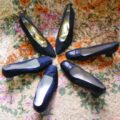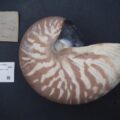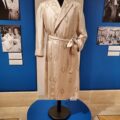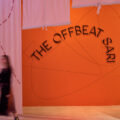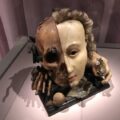Josef Frank – Furniture – Paintings – Review
February 9, 2017The Fashion and Textile Museum always have exhibitions to look forward to, and Josef Frank Patterns – Furniture – Paintings doesn’t disappoint. Huge colourful pink and orange flowers burst across the wall as you enter the show, and I dare you not to smile. An adjacent room setting looks cosy and calm enough to settle down in and read a magazine in.
Josef Frank was a mid century architect, furniture designer and fabric print designer. The Fashion and Textile Museum is having a textile season so naturally enough this show focuses on Joseph’s prints, along with a selection of his watercolours that were his private passion.
Now, this room setting: I said cosy and calm but that’s strange, because it features at least seven prints in different colours and styles, from rug to sofa to wallpaper and chest of drawers, and the furniture and accessories is not all from the mid century period – some of it looks suspiciously contemporary.
But that’s all right, because Josef Frank believed that for a room to be relaxing, it needs a minimum of eight different prints, and your furniture and ornaments can come from any time and place and be by any hand, as long as you like them – what ties them together is you.
Your taste curates the selection, and as for the multitude of prints, having a pattern to look at gives your mind a distraction and something to look at and work away at, instead of your every day worries. And in fact this room, despite the riot of prints, is gracious because a dark green wall is carefully chosen to match the predominantly leafy prints, and the floral sofa gives a jolly pop of colour.
The accessories in the room which are not designed by Joseph are, indeed, contemporary, from the Swedish company which he designed for and helped to make famous, Svenskt Tenn. It is still running today, and, as well as work by other designers, still produces his prints from the archive.
And what prints they are. The curator of the show, Dennis Nothdruft, describes them as looking as if they were designed yesterday, but I find this not quite true – the colours, the nubbly linen they are printed on, the something-about-them, places them firmly of their time. Yet this isn’t a fault, because they are joyous and charming, and would fit very well in today’s home as a conscious throwback.
The prints are colourful and their scale is huge and bold – something that looks striking today but would have been positively shocking in conservative 1930s Sweden, where Josef Frank first debuted them. Frank was a war refugee, born in Austria in 1885, who had a successful architectural practice there, which also produced furniture and textile prints. The principle was probably based on that of the Arts and Crafts designer William Morris, whose work he admired and which his own textile designs, often based on flora and fauna, resembled.
But these first prints, one of which hangs in the exhibition along with its original wooden printing block, were timid and gentle things. However they were clearly interesting enough for Estrid Ericson, the founder of Svenskt Tenn which at the time specialised in popular pewter ware, to offer Josef Frank a commission. This went well, and she offered him a job in Sweden. This being 1933, and the situation in Austria not looking good for those of Jewish ancestry like Frank, he accepted it and moved there with his Swedish wife.
This initiated the blossoming of his print career, though unfortunately the death of his architectural one as Frank could not find an opening for those skills in a Sweden suspicious of foreigners.
When he had to move to New York in 1940 as Sweden began to look dangerous for him too, he continued working for Svenskt Tenn. The prints he produced in food rationed New York, at a time when he and his family were still uncertain about their futures and the whole world looked bleak are some of his most vibrant.
Some of these you will recognise – “Italian Dinner” shows a scene where langoustine and octopi swim in a river beneath vines of tomatoes, aubergine, grapes and other ingredients, ready to make a meal. “Manhattan” takes the form of a map of the district in square cartouches, , with street names charmingly handwritten.
Both “US Tree” and “Vegetable Tree” feature a tree of life theme, where branches bear all kinds of vegetables or different US leaves respectively, growing on the same tree. Another design, “Poisons”, shows grapes, hops and the tobacco plants on a black background, looking sophisticated and desirable. “Dixieland”, another of his famous designs, groups huge pink watermelon with yellow sunflowers and bunches of bougainvillea on a vibrant blue background.
It is probable that Josef Frank never went to the American South, but it seems he enjoyed reading about it and imagining it. There is a small collection of illustrated field guides to US flora and fauna upstairs, along with facsimiles of letters and photographs, that shows his careful consideration of imagery.
Also upstairs are the watercolours. It seems that after designing hundreds of prints and many items of furniture, Josef Frank ran out of ideas. He retired, but turned to watercolours instead. These have been rediscovered lately by his family, and some are shown here for the first time since they were put away in linen folders by Frank himself. In letters to friends Josef Frank professed himself to be not a fluent painter, but still, happy and proud of his work. He could not have been entirely embarrassed as he allowed his friends to leaf through the folders occasionally and choose a painting for themselves.
Yet it is true, these paintings are no masterpieces. Frank used watercolour to compose his print designs so was familiar with the medium, but his naive touch which is so charming on the textiles fails him on his paintings, and where the prints were free and exuberant, the watercolours are stiff, constrained, and very literal views of, say, the unremarkable London street he happened to be staying in at the time of painting. This is surprising, since you almost imagine he would paint some Henri Rousseau-esque scene from his imagination, lush with tropical plants and strange beasts.
But it is still a beautiful show and one I recommend visiting.
Josef Frank Patterns – Furniture – Painting is on at the Fashion and textile museum from 28th Jan to 7th May 2017



